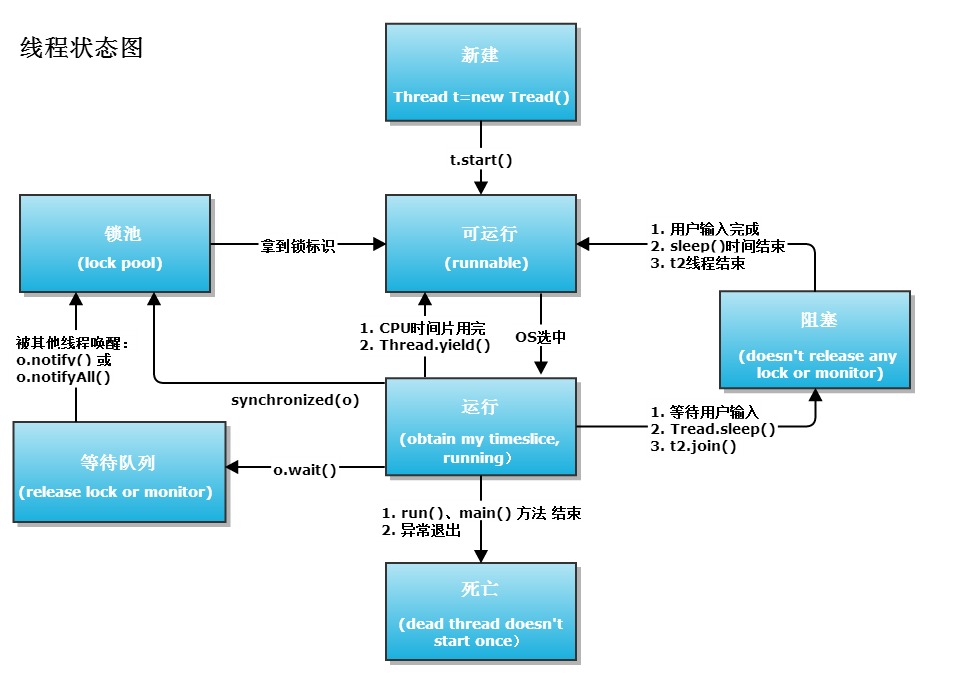1、多线程状态
下图是多线程的状态图:

线程间的状态转换:
1. 新建(new):新创建了一个线程对象。
2. 可运行(runnable):线程对象创建后,其他线程(比如main线程)调用了该对象的start()方法。该状态的线程位于可运行线程池中,等待被线程调度选中,获取cpu 的使用权 。
3. 运行(running):可运行状态(runnable)的线程获得了cpu 时间片(timeslice) ,执行程序代码。
4. 阻塞(block):阻塞状态是指线程因为某种原因放弃了cpu 使用权,也即让出了cpu timeslice,暂时停止运行。直到线程进入可运行(runnable)状态,才有机会再次获得cpu timeslice 转到运行(running)状态。阻塞的情况分三种:
(一). 等待阻塞:运行(running)的线程执行o.wait()方法,JVM会把该线程放入等待队列(waitting queue)中。
(二). 同步阻塞:运行(running)的线程在获取对象的同步锁时,若该同步锁被别的线程占用,则JVM会把该线程放入锁池(lock pool)中。
(三). 其他阻塞:运行(running)的线程执行Thread.sleep(long ms)或t.join()方法,或者发出了I/O请求时,JVM会把该线程置为阻塞状态。当sleep()状态超时、join()等待线程终止或者超时、或者I/O处理完毕时,线程重新转入可运行(runnable)状态。
5. 死亡(dead):线程run()、main() 方法执行结束,或者因异常退出了run()方法,则该线程结束生命周期。死亡的线程不可再次复生。
2、多线程方法
2.1 Thread.yield方法
使当前线程从执行状态(运行状态)变为可执行态(就绪状态),cpu会从众多的可执行态里选择,也就是说,当前也就是刚刚的那个线程还是有可能会被再次执行到的,并不是说一定会执行其他线程而该线程在下一次中不会执行到了。
方法体:
/**
* A hint to the scheduler that the current thread is willing to yield
* its current use of a processor. The scheduler is free to ignore this
* hint.
*
* <p> Yield is a heuristic attempt to improve relative progression
* between threads that would otherwise over-utilise a CPU. Its use
* should be combined with detailed profiling and benchmarking to
* ensure that it actually has the desired effect.
*
* <p> It is rarely appropriate to use this method. It may be useful
* for debugging or testing purposes, where it may help to reproduce
* bugs due to race conditions. It may also be useful when designing
* concurrency control constructs such as the ones in the
* {@link java.util.concurrent.locks} package.
*/
public static native void yield();
2.2.join方法
join把指定的线程加入到当前线程,实现两个交替执行的线程合变为顺序执行的线程。比如在线程B中调用了线程A的join()方法,直到线程A执行完毕后,才会继续执行线程B。
方法体:
public final synchronized void join(long millis)
throws InterruptedException {
long base = System.currentTimeMillis();
long now = 0;
if (millis < 0) {
throw new IllegalArgumentException("timeout value is negative");
}
if (millis == 0) {
while (isAlive()) {
wait(0);
}
} else {
while (isAlive()) {
long delay = millis - now;
if (delay <= 0) {
break;
}
wait(delay);
now = System.currentTimeMillis() - base;
}
}
}